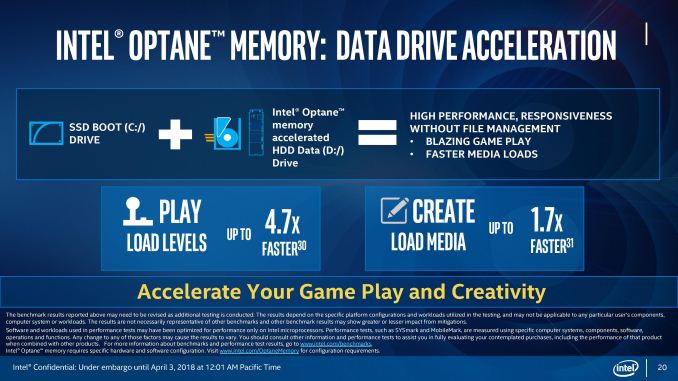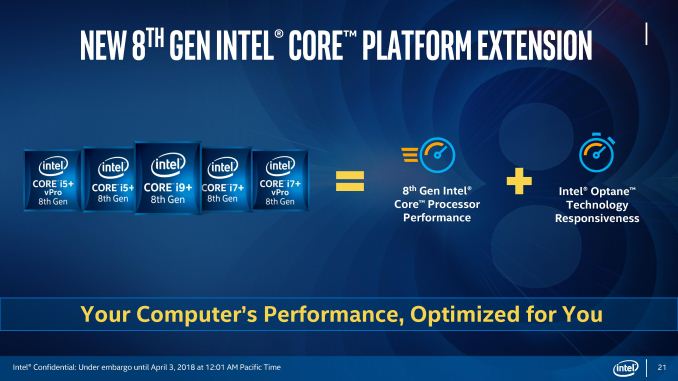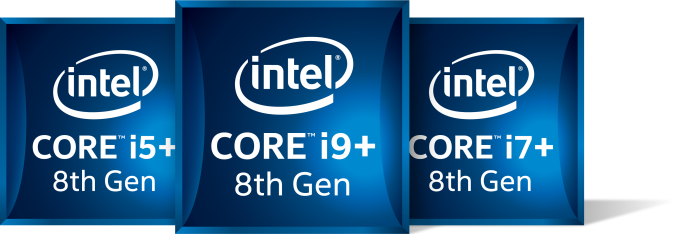Intel Expands 8th Gen Core: Core i9 on Mobile, Iris Plus, Desktop, Chipsets, and vPro
by Ian Cutress on April 3, 2018 3:01 AM ESTNew Optane Branding
Core i9+, Core i7+, Core i5+
One of the items that Intel is keen to promote with this launch is an update to its Intel RST algorithm when dealing with ‘Optane Memory’, Intel’s brand for Optane whereby a small amount of storage is placed in front of a larger drive to act as a fast cache. Up to this point, Intel platforms that supported Optane Memory in this configuration could only do so on the drive that was used to boot into the operating system. While this worked well for low-cost users that relied on a single rotational hard-disk drive of rust for their needs, with most enthusiasts using a fast SSD (SATA or PCIe) as their first drive that loads the OS, putting Optane Memory in front of this as a cache was relatively pointless – any gains would be intangible at best. With the new generation of products, Intel has expanded the capabilities of Optane Memory such that it can act as a cache for a non-OS drive. This means that a user can have a fast SSD boot drive, a large spinning drive for storage, and then place Optane in front of that storage drive to potentially get much better performance from the drive.
The main idea here is that the large rotational drive is where users store games and large files used in content creation, which often have a long loading time. With the right caching algorithm, and a decent sized Optane Memory drive, Intel likes to promote that loading games and loading media for creative purposes are several factors faster than an equivalent system without an Optane Memory drive.
Part of the news around Optane is that Intel is now creating new processor branding for OEMs that have configurations with Optane. The new brands and logos are similar to the standard Core i5/i7 style that we are used to, however the logos are now a dark blue with white text, and exhibit a plus after the Core i5/i7 name.
So just to be clear, this is not a new line of processors. We will not have to suddenly deal with a Core i9+-8950HK being different to the non-plus counterpart. This is purely a branding exercise, and one that only covers the i5 and higher at that. However, to complicate things, this means that specification sheets can (and will) list the processors as Core i5+ and Core i7+ and even vPro models. This makes looking for particular processor versions in search engines a lot more difficult for almost no obvious benefit. I mean sure, Intel wants to promote the use of its Optane drives, but we already have the Optane branding and the Optane logos to do that for us. This ends up being another logo put onto the box.
Ultimately, Intel is still marketing Optane, its high-cost R&D product, with low capacities at low cost systems with relatively little margin. While it might seem like a noble goal, to bring extra caching performance down to the lower cost segment, it could very easily be done with SATA or PCIe M.2 drives using regular NAND flash. A lot of users would like to see high-capacity, high-endurance Optane drives moving more into the mainstream, instead of more attempts at funneling in a product like Optane into caching.













123 Comments
View All Comments
satai - Wednesday, April 4, 2018 - link
When you buy Core, you just buy the number of cores you want. Ignore everything else (unless you have some niche needs such as ECC).close - Wednesday, April 4, 2018 - link
@satai, stop being a shill. You already use some arguments that don't make sense (like insisting that everybody who buys a laptop knows the TDP of the CPU and can make the difference for performance based on that - which is asinine but here you are claiming it).Intel has been muddying the waters when it comes to branding for at least a decade. Dozens of SKUs meant only to confuse even people with more than basic knowledge. Mixed model numbers and random feature allocation that even this article confirms. Unless you walk around with the slide deck or learned the ARK website by heart you'll never know what model does what and what the numbering represents.
The Ryzen naming scheme is pretty clear and understandable at least by comparison. And while it could create some confusion between mobile and desktop specs, that's minor. There's a very solid overlap in corecount between mobile and desktop (like 4/4 and 4/8 models in the in the 3 and 5 ranges).
And I'm pretty sure it was done simply because it's the only way to fight a company that sold you the same crappy advancements YoY for a boatload of money. If even AT kicks Intel to the curb you know that whoever is defending them is either paid to do it or needs some adult supervision.
satai - Wednesday, April 4, 2018 - link
"nsisting that everybody who buys a laptop knows the TDP of the CPU"I don't say or think such a thing.
"Dozens of SKUs meant only to confuse even people with more than basic knowledge"
google with site:ark.intel.com
If you are not able o do this...
"The Ryzen naming scheme is pretty clear and understandable at least by comparison. "
Partly because AMD competes only in some segments...
"There's a very solid overlap in corecount between mobile and desktop (like 4/4 and 4/8 models in the in the 3 and 5 ranges)."
So you need to have apriori knowledge that this is about 5 and 3 and not for 7 anyway...
ToTTenTranz - Tuesday, April 3, 2018 - link
This update seems to put Microsoft in an awkward position for their high-end Surface Pro.They've been using the 15W Iris Pro part for high-end for quite a while. All of a sudden Intel only has 28W parts with Iris Pro. A visit to the ark website tells us all these Iris Pro 655 models only have a cTDP down to 20W, which is may not be nearly enough for Surface Pro's cooling system.
One would think the Ryzen 2700U would be the perfect replacement candidate for Microsoft, but the lack of LPDDR support may prove "mortal" for tablets, as we're yet to see a single 12" tablet with detachable keyboard based off AMD's 15W offerings.
But most of all why the hell are all these new sub-35W APU offerings not coming with LPDDR4 support? Looks like such a waste..
Gunbuster - Tuesday, April 3, 2018 - link
You make it sound like MS is not already in an awkward position on Surface after hitting a brick wall trying to get into Enterprise business and having on average eight daily visitors to their brick and mortar stores.PeachNCream - Tuesday, April 3, 2018 - link
"Many people expect Apple to be Intel’s biggest customer with these parts, however the future of the product line is unclear, with Intel unwilling to discuss the roadmap on what is being called ‘Kaby Lake-G’."There's already been recent news about Apple possibly moving to a different CPU supplier in Macintosh systems in 2020, so less than 2 years from now. Maybe in the short term, Apple will be a customer for such chips, but the mid- to long-term future appears to be quite different. Here's a link to a source article about that:
http://www.latimes.com/business/technology/la-fi-t...
Ratman6161 - Tuesday, April 3, 2018 - link
Apple has been hovering around 8% - 10% market share in laptops and a bit lesser share for desktops for a very long time. 10% is certainly enough for Intel to take notice but not enough for them to be coming out with CPU's specifically for them.satai - Wednesday, April 4, 2018 - link
Apple sells/buys with above average prices. That makes them pretty valuabe customer.Intel did some tweaks of CPUs for them before (smaller packaging for C2D for Air and possibly others).
12Parsecs - Wednesday, April 4, 2018 - link
https://ark.intel.com/products/77912/Intel-Xeon-Pr...;-)
tipoo - Tuesday, April 3, 2018 - link
There we go, ULV quads and Iris Plus were probably what the 13" rMBP was waiting on.